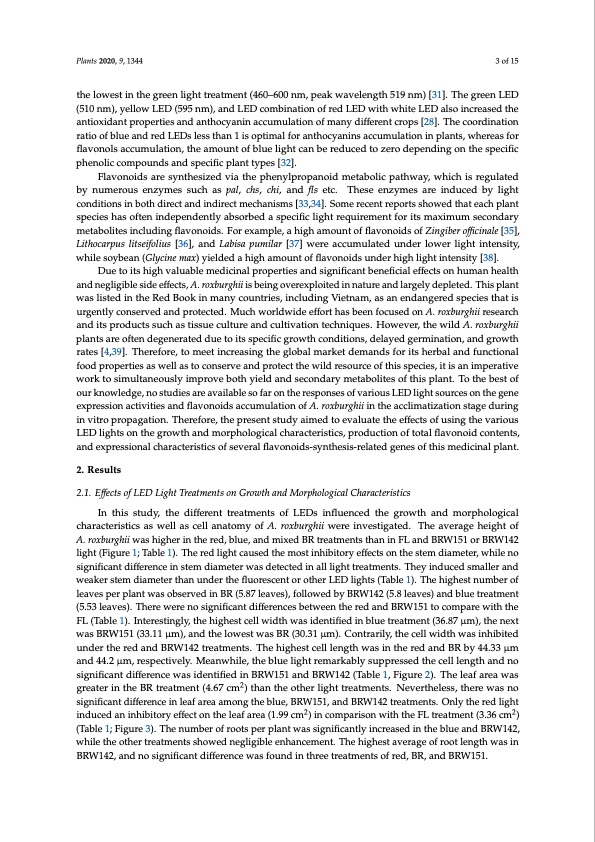
PDF Publication Title:
Text from PDF Page: 003
Plants 2020, 9, 1344 3 of 15 the lowest in the green light treatment (460–600 nm, peak wavelength 519 nm) [31]. The green LED (510 nm), yellow LED (595 nm), and LED combination of red LED with white LED also increased the antioxidant properties and anthocyanin accumulation of many different crops [28]. The coordination ratio of blue and red LEDs less than 1 is optimal for anthocyanins accumulation in plants, whereas for flavonols accumulation, the amount of blue light can be reduced to zero depending on the specific phenolic compounds and specific plant types [32]. Flavonoids are synthesized via the phenylpropanoid metabolic pathway, which is regulated by numerous enzymes such as pal, chs, chi, and fls etc. These enzymes are induced by light conditions in both direct and indirect mechanisms [33,34]. Some recent reports showed that each plant species has often independently absorbed a specific light requirement for its maximum secondary metabolites including flavonoids. For example, a high amount of flavonoids of Zingiber officinale [35], Lithocarpus litseifolius [36], and Labisa pumilar [37] were accumulated under lower light intensity, while soybean (Glycine max) yielded a high amount of flavonoids under high light intensity [38]. Due to its high valuable medicinal properties and significant beneficial effects on human health and negligible side effects, A. roxburghii is being overexploited in nature and largely depleted. This plant was listed in the Red Book in many countries, including Vietnam, as an endangered species that is urgently conserved and protected. Much worldwide effort has been focused on A. roxburghii research and its products such as tissue culture and cultivation techniques. However, the wild A. roxburghii plants are often degenerated due to its specific growth conditions, delayed germination, and growth rates [4,39]. Therefore, to meet increasing the global market demands for its herbal and functional food properties as well as to conserve and protect the wild resource of this species, it is an imperative work to simultaneously improve both yield and secondary metabolites of this plant. To the best of our knowledge, no studies are available so far on the responses of various LED light sources on the gene expression activities and flavonoids accumulation of A. roxburghii in the acclimatization stage during in vitro propagation. Therefore, the present study aimed to evaluate the effects of using the various LED lights on the growth and morphological characteristics, production of total flavonoid contents, and expressional characteristics of several flavonoids-synthesis-related genes of this medicinal plant. 2. Results 2.1. Effects of LED Light Treatments on Growth and Morphological Characteristics In this study, the different treatments of LEDs influenced the growth and morphological characteristics as well as cell anatomy of A. roxburghii were investigated. The average height of A. roxburghii was higher in the red, blue, and mixed BR treatments than in FL and BRW151 or BRW142 light (Figure 1; Table 1). The red light caused the most inhibitory effects on the stem diameter, while no significant difference in stem diameter was detected in all light treatments. They induced smaller and weaker stem diameter than under the fluorescent or other LED lights (Table 1). The highest number of leaves per plant was observed in BR (5.87 leaves), followed by BRW142 (5.8 leaves) and blue treatment (5.53 leaves). There were no significant differences between the red and BRW151 to compare with the FL (Table 1). Interestingly, the highest cell width was identified in blue treatment (36.87 μm), the next was BRW151 (33.11 μm), and the lowest was BR (30.31 μm). Contrarily, the cell width was inhibited under the red and BRW142 treatments. The highest cell length was in the red and BR by 44.33 μm and 44.2 μm, respectively. Meanwhile, the blue light remarkably suppressed the cell length and no significant difference was identified in BRW151 and BRW142 (Table 1, Figure 2). The leaf area was greater in the BR treatment (4.67 cm2) than the other light treatments. Nevertheless, there was no significant difference in leaf area among the blue, BRW151, and BRW142 treatments. Only the red light induced an inhibitory effect on the leaf area (1.99 cm2) in comparison with the FL treatment (3.36 cm2) (Table 1; Figure 3). The number of roots per plant was significantly increased in the blue and BRW142, while the other treatments showed negligible enhancement. The highest average of root length was in BRW142, and no significant difference was found in three treatments of red, BR, and BRW151.PDF Image | LED Lights Promote Growth and Flavonoid Accumulation of Anoectochilus roxburghii

PDF Search Title:
LED Lights Promote Growth and Flavonoid Accumulation of Anoectochilus roxburghiiOriginal File Name Searched:
plants-09-01344.pdfDIY PDF Search: Google It | Yahoo | Bing
Cruise Ship Reviews | Luxury Resort | Jet | Yacht | and Travel Tech More Info
Cruising Review Topics and Articles More Info
Software based on Filemaker for the travel industry More Info
The Burgenstock Resort: Reviews on CruisingReview website... More Info
Resort Reviews: World Class resorts... More Info
The Riffelalp Resort: Reviews on CruisingReview website... More Info
| CONTACT TEL: 608-238-6001 Email: greg@cruisingreview.com | RSS | AMP |